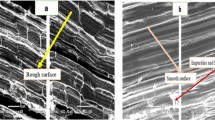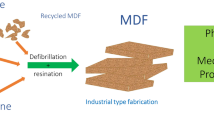Abstract
In order to better utilize agricultural fibers as an alternative resource for composite panels, several variables were investigated to improve mechanical and physical properties of agro-based fiberboard. This study focused on the effect of fiber morphology, slenderness ratios (L/D), and fiber mixing combinations on panel properties. The panel construction types were also investigated such as hardboard (HB), medium density fiberboard (MDF), and bagasse core panel (BCP) made from bagasse/bamboo combinations with a combination of 1% pMDI/4% UF as a binder. Static bending properties and tensile strength increased as fiber L/D increased from 3 to 26. Fiber separation and morphology also influenced the mechanical property development of agro-based panels. Bagasse fiber bundles and particles smaller than L/D of 5.4 were responsible for the mechanical property loss of agro-based MDF. The BCP yielded promising results for modulus of elasticity (MOE) and modulus of rupture (MOR). However, HB appeared to be a better panel type for agro-based composites based on the property enhancement compared to wood-based panel products.
Zusammenfassung
Um landwirtschaftliche Fasern als alternativen Rohstoff für Verbundplatten besser nutzen zu können, wurden verschiedene Faktoren zur Verbesserung der mechanischen und physikalischen Eigenschaften von Faserplatten aus landwirtschaftlichen Rohstoffen untersucht. Diese Studie beschäftigt sich in erster Linie mit der Wirkung von Fasermorphologie, Schlankheitsgrad (L/D) und möglichen Fasermischungen auf die Eigenschaften von Hartfaserplatten (HB), mitteldichten Faserplatten (MDF) und Verbundplatten aus Bambus mit unterschiedlich dicken Bagasse-Mittellagen (BCP) und einer Mischung aus 1% pMDI/4% UF als Bindemittel. Mit steigendem Schlankheitsgrad von 3 auf 26 nahmen statische Biegefestigkeit und E-Modul zu. Ausserdem beeinflussten auch Fasertrennung und -morphologie die mechanischen Eigenschaften der Platten aus landwirtschaftlichen Rohstoffen. Bagasse-Faserbündel sowie Partikel mit einem niedrigeren Schlankheitsgrad als 5,4 führten zu schlechten mechanischen Eigenschaften von MDF aus landwirtschaftlichen Rohstoffen. BCP zeigte viel versprechende Ergebnisse in puncto Elastizitätsmodul (MOE) und Biegefestigkeit (MOR). Geht man jedoch von einer Verbesserung der Eigenschaften im Vergleich zu Holzplatten aus, so scheint sich HB als Verbundwerkstoff aus landwirtschaftlichen Rohstoffen besser zu eignen.
Similar content being viewed by others
References
American National Standard Institute (ANSI) (1995) Basic hardboard. ANSI/AHA 135.4 (Approved Jan. 5, 1995). American national standard institute, American hardboard Association, Palatine, IL, USA
American Society for Testing and Materials (ASTM) (1999) Standard test methods for evaluating properties of wood-based fiber and particle panel materials. Vol. 04.10, ASTM D 1037-99. West Conshohocken, PA, USA
Atchison JE, Lengel DE (1985) Rapid growth in the use of bagasse as a raw material for reconstituted panelboard. In: Proceedings of the 19th international particleboard/ composite materials symposium, Pullman, WA, USA
Bekhta P, Hiziroglu S (2002) Theoretical approach on specific surface area of wood particles. Forest Prod J 52(4):72–76
Dunky M (1998) Particle size distribution and glue resin consumption: how to spare costs. In: Proceedings of the 2nd panel products symposium, Llandudno, Wales, UK
Grigoriou AH (2000) Straw-wood composites bonded with various adhesive systems. Wood Sci Technol 34:355–365
Han JS (1998) Properties of nonwood fibers. In: Proceedings of Korean society of wood science and technology annual meeting. Seoul, Korea
Hill MD, Wilson JB (1978) Particleboard strength as affected by unequal resin distribution on different particle fractions. Forest Prod J 28(11):44–48
Hse CY, Choong ET (2000) Modified formaldehyde-based resin adhesives for rice husk/wood particleboard. In: 5th pacific Rim Bio-based composites symposium, Canberra, Australia
Iñiguez-Covarrubias G, Lange SE, Rowell RM (2001) Utilization of byproducts from the tequila industry. Part 1: Agave bagasse as a raw material for animal feeding and fiberboard production. Bioresource Technol 77:25–32
Jain S, Kumar R, Jindal UC (1992) Mechanical behavior of bamboo and bamboo composite. J Mater Sci 27:4598–4604
Jindal UC (1986) Development and testing of Bamboo-Fiber Reinforced Plastic Composites. J Composite Mater 20:19–29
Lee AWC, Bai X, Bangi AP (1997) Flexural properties of bamboo-reinforced southern pine OSB beams. Forest Prod J 47(6):74–78
Li Y, Mai YW, Ye L (2000) Sisal fibre and its composites: a review of recent developments. Compos Sci Tech 60:2037–2055
Liang B-H, Shaler SM, Matt L, Groom L (1994) Recycled fiber quality from a laboratory-scale blade separator/blender. Forest Prod J 44(7/8):47–50
Maloney TM (1970) Resin distribution in layered particleboard. Forest Prod J 20(1):43–52
Maloney TM (1993) Modern particleboard & dry-process fiberboard manufacturing. Miller Freeman Publications, San Francisco, CA, USA
Mobarak F, Fahmy Y, Augustin H (1982) Binderless lignocellulose composite from bagasse and mechanism of self-bonding. Holzforschung 36:131–135
Pizzi A (1994) Advanced Wood Adhesives Technology. Marcel Dekker Inc, New York, pp 58–60
Sefain MZ, Naim NA, Rakha M (1978) Effect of thermal treatment on the properties of sugar cane bagasse hardboard. J Appl Chem Biotechn 28(2):79–84
Seth RS (1995) The effect of fiber length and coarseness on the tensile strength of wet webs: a statistical geometry explanation. Tappi J 78(3):99–102
Simon C, George B, Pizzi A (2002) Copolymerization in UF/pMDI adhesives networks. J Appl Polym Sci 86(14):3681–3688
Sulastiningsih IM, Nurwati1 SM, Kawai S (2002) The effects of bamboo: cement ratio and magnesium chloride (MgCl2) content on the properties of bamboo–cement boards. ACIAR Proceedings No. 107, Canberra, Australia
Technical Association of the Pulp and Paper Industry (TAPPI) standards (1995) Fiber length of pulp by classification. T 233 cm-95 Atlanta, GA, USA
Yusoff MNM, Kadir AA, Mohamed AH (1994) Utilization of bamboo for pulp and paper and medium density fiberboard. In: Proceedings of national bamboo seminar I, Kuala Lumpur, Malaysia
Zhang M, Kawai S, Yusuf S, Imamura Y, Sasaki H (1997) Manufacture of wood composites using lignocellulosic materials and their properties III. Properties of bamboo particleboards and dimensional stability improvement by using a steam-injection press. Mokuzai Gakkaishi 43(4):318–326
Author information
Authors and Affiliations
Corresponding author
Rights and permissions
About this article
Cite this article
Lee, S., Shupe, T. & Hse, C. Mechanical and physical properties of agro-based fiberboard. Holz Roh Werkst 64, 74–79 (2006). https://doi.org/10.1007/s00107-005-0062-z
Published:
Issue Date:
DOI: https://doi.org/10.1007/s00107-005-0062-z




